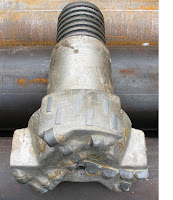Understanding drilling technology and learning how it would handle the rocks of the Alpine Fault was a primary objective of phase 1 of our project. We definitely have been on a steep learning curve over the last few days.

We successfully grouted the lost casing shoe in place and cut through it, but we have now used quite a number of different steel casings. The outer casing (with lost shoe) has an internal diameter (ID) of 150 mm and reached 34 m. We then installed a
our PQ drill string from rattling about. We then inserted our drill string with core barrel and advanced the casing as we cored down. However, even after cutting away the lost shoe, it was very slow progress and veryPWT casing with ID 130 mm, to stop
poor core. By noon today we had still only reached a depth of 45 m and had little to show for it. We decided to abandon coring until we were closer to the fault.
First photo: Diamond coring bit and reamer.
 Second photo : Poor core recovery with many fragments of collapsed borehole in the core barrel and a very short run of intact rock. Rates of drilling were less than 1 m per hour and this was one of the best cores collected.
Second photo : Poor core recovery with many fragments of collapsed borehole in the core barrel and a very short run of intact rock. Rates of drilling were less than 1 m per hour and this was one of the best cores collected.
 Second photo : Poor core recovery with many fragments of collapsed borehole in the core barrel and a very short run of intact rock. Rates of drilling were less than 1 m per hour and this was one of the best cores collected.
Second photo : Poor core recovery with many fragments of collapsed borehole in the core barrel and a very short run of intact rock. Rates of drilling were less than 1 m per hour and this was one of the best cores collected.In the meantime work continued on instruments to be put down the borehole, and people caught up on a bit of sleep. The rain was heavy at times and some were probably (secretly) a little glad that we did not have to work in a wet tent through the night.
We replaced the coring bit with a flat bit, in an attempt to more rapidly create an open hole. Unfortunately, this didn’t seem to work. It seemed that the borehole wall was causing us problems, providing fragments that were jamming against the drill rods. Very frustrating. Alan Speight, our head driller, then suggested that we try to increase the size of the annulus, so that cuttings had more space to escape. He came up with the
cunning plan of attaching the same size bit onto thinner drill rods, but welded some spacers to the rods, to keep them central and hence the hole straight. Finally, this seemed to be working. Between 10 pm and 11 pm we drilled 4 m.
Below. A cutting bit designed to create an open hole the same size (123 mm) as a PQ coring system, but the bit is attached to drill rods used with the smaller HQ coring system. Steel bars welded in place keep the rods central within the hole.


